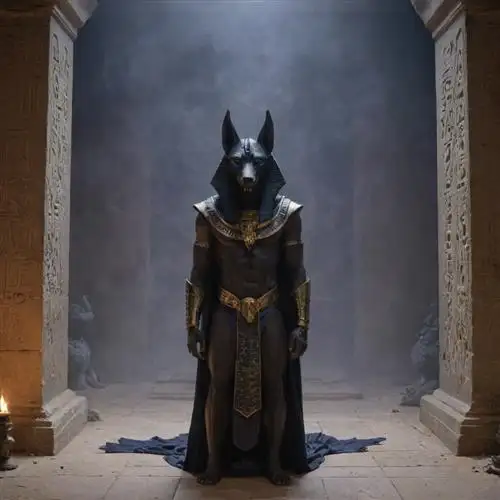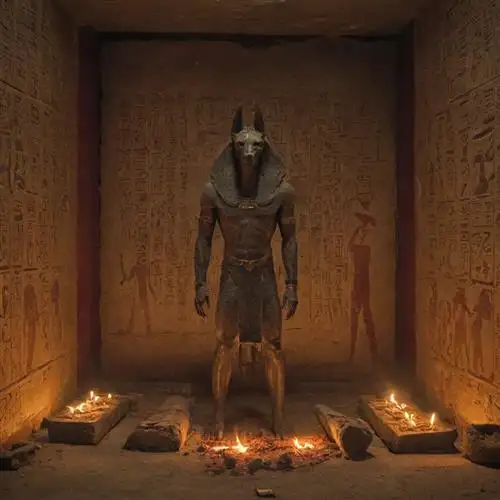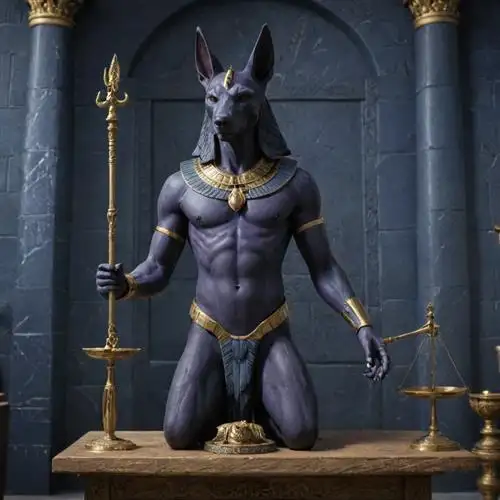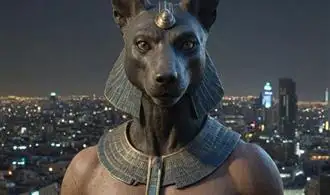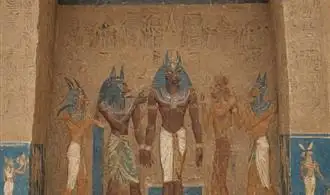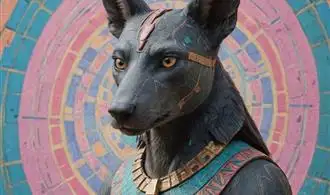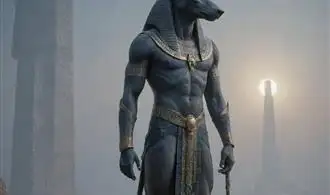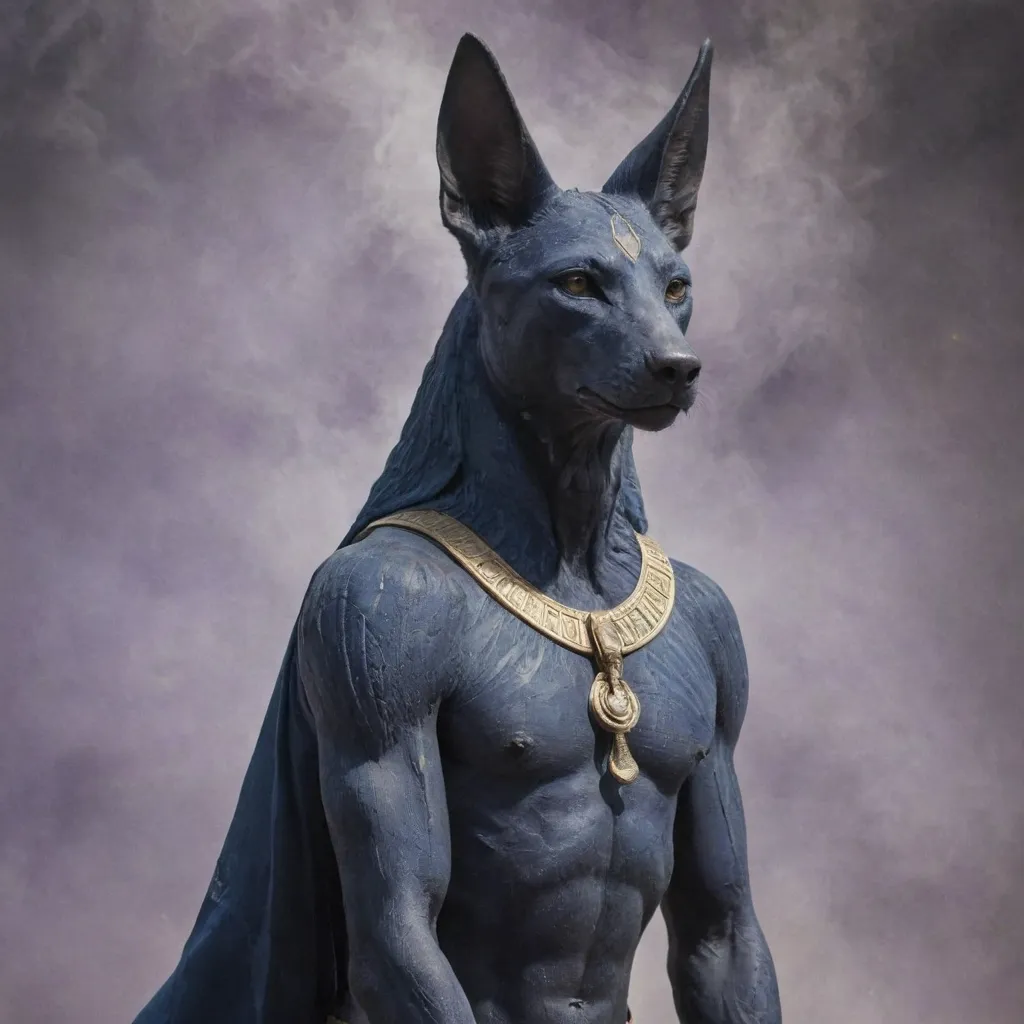
The Ancient Roots of Anubis
Anubis, the ancient Egyptian deity associated with the afterlife, has a rich and captivating history that stretches back thousands of years. This canine-headed figure was revered as the patron of mummification and the guardian of the dead, playing a crucial role in the Egyptian conception of the afterlife.
Scholars believe that Anubis originated as a local funerary god in the region of Abydos, a site renowned for its necropolis and as the burial place of the god Osiris. The earliest known depictions of Anubis date back to the Early Dynastic period (c. 3050–2686 BCE), where he was represented as a jackal or a jackal-headed man. This association with the jackal was likely due to the animal's propensity to prowl around cemeteries and feed on the remains of the deceased, leading the Egyptians to view the jackal as a symbolic link between the world of the living and the world of the dead.
As the cult of Anubis grew in prominence, his role expanded to encompass a wide range of funerary and afterlife-related responsibilities. He was tasked with overseeing the embalming process, ensuring the proper preparation and preservation of the deceased. Anubis was also believed to be present at the weighing of the heart ceremony, a crucial step in the Egyptian conception of the afterlife, where the deceased's heart was weighed against the feather of truth to determine their moral worth and fitness for the afterlife.
The significance of Anubis in the Egyptian pantheon is further highlighted by his inclusion in numerous mythological narratives. In the Osirian myth, Anubis played a crucial role in the resurrection of Osiris, the god of the dead, after his murder at the hands of his brother, Seth. Anubis was responsible for embalming Osiris's body, preserving it for the afterlife and ensuring his eventual return to life.
Anubis The Gatekeeper of the Underworld
Anubis, the ancient Egyptian god associated with mummification and the afterlife, is often revered as the Gatekeeper of the Underworld. This enigmatic deity played a crucial role in the complex religious beliefs and practices of ancient Egypt, guiding the deceased through the treacherous realms of the afterlife. As the archetypal psychopomp, Anubis was responsible for the safe passage of the dead, ensuring their successful transition to the next phase of existence.
At the heart of Anubis' role as the Gatekeeper of the Underworld lies his deep connection to the process of mummification. As the god who presided over the embalming and preparation of the deceased, Anubis was believed to possess a profound understanding of the intricate rituals and techniques required to preserve the body. This intimate knowledge of the physical and spiritual aspects of death made Anubis an indispensable figure in the ancient Egyptian funerary rites, as he guided the deceased through the complex journey of the afterlife.
Anubis' role as the Gatekeeper of the Underworld extended beyond the physical realm, as he was also believed to be the guardian of the metaphysical thresholds that separated the living from the dead. In this capacity, Anubis was responsible for weighing the heart of the deceased against the feather of truth, a crucial step in the judgment process that determined the fate of the soul. This ritual, known as the "Weighing of the Heart," was a pivotal moment in the journey of the deceased, as it determined whether they would be granted access to the afterlife or condemned to eternal damnation.
The symbolic significance of Anubis as the Gatekeeper of the Underworld extends far beyond his role in the funerary rites of ancient Egypt. As a figure who stood at the threshold between the realms of the living and the dead, Anubis came to represent the ultimate guardian of transformation and personal growth. In this sense, Anubis is often seen as a powerful archetype for those seeking to unlock their hidden potential, guiding them through the metaphorical "underworld" of their own psyche and facilitating their personal transformation.
Unlocking the Secrets of Anubis Rituals
Anubis, the ancient Egyptian god of the dead, has long been revered for his ability to guide the deceased through the afterlife. However, his influence extends far beyond the realm of the dead. Practitioners of various spiritual and esoteric traditions have discovered that connecting with the energy of Anubis can unlock hidden potentials within the self, leading to profound personal transformation and growth.
At the core of Anubis rituals lies the principle of transformation. Anubis is associated with the process of death and rebirth, a symbolic journey that allows individuals to shed outdated beliefs, habits, and limiting patterns. By engaging with Anubis rituals, one can tap into the god's powerful energy to facilitate a metaphorical "death" of the old self, paving the way for the emergence of a renewed, empowered version of the individual.
One of the most potent Anubis rituals is the Ritual of the Jackal. This ceremony invokes the presence of Anubis and is designed to help individuals confront and overcome their deepest fears and shadows. Through this ritual, participants are able to explore the darker aspects of their psyche, gaining a deeper understanding of the subconscious forces that shape their thoughts, emotions, and behaviors.
Another powerful Anubis ritual is the Rite of Rebirth. This ritual focuses on facilitating a profound transformation, allowing individuals to let go of old patterns and embrace a new, more authentic version of themselves. By aligning with the energy of Anubis, participants can experience a deep cleansing and purification, releasing the shackles of the past and stepping into a future filled with limitless potential.
In addition to these specific rituals, many practitioners also incorporate Anubis-inspired meditations and visualizations into their spiritual practice. These practices can help individuals connect with the energy of Anubis, tapping into his wisdom and guidance to uncover hidden aspects of the self and unlock new avenues for growth and self-discovery.
Anubis and the Weighing of the Heart
At the heart of the ancient Egyptian belief system lies the intricate ritual of the Weighing of the Heart, a crucial component of the journey to the afterlife. Anubis, the jackal-headed deity, plays a pivotal role in this sacred ceremony, serving as the guardian and overseer of this profound moment.
In the ancient Egyptian conception, the heart was believed to be the center of one's being, the seat of the soul and the embodiment of a person's deeds, thoughts, and emotions. Upon death, the deceased would undergo a meticulous judgment process, where their heart would be weighed against the feather of Maat, the goddess of truth, justice, and cosmic order.
Anubis, the god of embalming and the protector of the dead, was responsible for overseeing this critical stage of the afterlife journey. As the deceased entered the Hall of Judgment, Anubis would carefully place the heart of the individual on one side of a scale, while the feather of Maat was placed on the other. This delicate balance symbolized the measure of the person's moral, ethical, and spiritual worthiness.
If the heart proved to be heavier than the feather, it was considered unworthy, and the individual would face dire consequences, potentially being devoured by the monstrous Ammit, a composite creature with the head of a crocodile, the body of a lion, and the hindquarters of a hippopotamus. However, if the heart was found to be in perfect equilibrium with the feather, the deceased would be granted passage to the realm of the afterlife, where they would dwell in eternal peace and harmony.
The Weighing of the Heart ceremony held profound significance, as it not only determined the fate of the individual but also served as a powerful metaphor for the importance of living a virtuous and balanced life. The ancient Egyptians believed that by aligning one's heart with the principles of Maat, they could unlock their hidden potential and secure a favorable outcome in the afterlife.
Anubis in Modern Esoteric Practices
Anubis, the ancient Egyptian god of the dead, has captivated the minds of esoteric practitioners for centuries. Beyond his traditional role as the guardian of the underworld, Anubis has become a powerful symbol in modern esoteric practices, unlocking hidden potential and guiding individuals on their spiritual journeys.
In the realm of esoteric rituals and meditations, Anubis is often invoked to assist in the process of self-transformation and personal growth. His connection to the underworld and the mysteries of death and rebirth make him a potent ally for those seeking to confront their innermost fears, unlock subconscious blocks, and tap into their hidden reserves of strength and wisdom.
One of the key ways Anubis is utilized in modern esoteric practices is through guided visualizations and journeys. Practitioners may engage in meditations where they visualize themselves traveling to the realm of Anubis, seeking his guidance and wisdom. These experiences can provide profound insights, allowing individuals to connect with the deeper aspects of their psyche and uncover hidden talents or abilities.
Additionally, Anubis is often invoked in rituals and ceremonies aimed at facilitating transitions, whether it be the ending of a significant life chapter or the beginning of a new journey. His role as the guardian of the underworld makes him a powerful ally in initiating transformative processes, guiding individuals through the challenging passages of life and death.
In some esoteric traditions, Anubis is also associated with the concept of the "shadow self," the aspects of our personality that we often try to repress or ignore. By working with Anubis, practitioners can engage in deep self-exploration, confronting their own shadows and integrating the hidden parts of themselves into a more holistic and empowered sense of self. This process can lead to a greater understanding of one's true nature and the unlocking of untapped potential.


